by Bruce Wells | Feb 12, 2024 | This Week in Petroleum History
February 12, 1954 – First Nevada Oil Well –
After hundreds of dry holes (the first drilled near Reno in 1907), Nevada became a petroleum-producing state. Shell Oil Company’s second test of its Eagle Springs No. 1 well in Nye County produced commercial amounts of oil. The routine test revealed petroleum production from depths between 6,450 feet and 6,730 feet.

Nevada’s annual oil production peaked in 1990 at about 4 million barrels of oil. Chart courtesy Nevada Division of Minerals.
Although the Eagle Springs field eventually produced 3.8 million barrels of oil, finding Nevada’s second oilfield took two more decades. Northwest Exploration Company completed the Trap Spring No. 1 well in Railroad Valley, five miles west of the Eagle Springs oilfield in 1976.
Learn more in First Nevada Oil Well.

February 12, 1987 – Texaco Fine upheld for Getty Oil Takeover attempt
A Texas court upheld a 1985 decision against Texaco for having initiated an illegal takeover of Getty Oil after Pennzoil had made a bid for the company. By the end of the year, the companies settled their historic $10.3 billion legal battle for $3 billion when Pennzoil agreed to drop its demand for interest.
According to the Los Angeles Times, the compromise was vital for a reorganization plan for Texaco emerging from bankruptcy, a haven it had sought to stop Pennzoil from enforcing the largest court judgement ever awarded at the time.
February 13, 1924 – Forest Oil adopts Yellow Dog Logo
Forest Oil Company, founded in 1916 as an oilfield service company by Forest Dorn and his father Clayton, adopted a logo featuring the two-wicked “yellow dog” oilfield lantern. The logo included a keystone shape to symbolized the state of Pennsylvania, where Forest Oil pioneered water-flooding methods to improve production from the 85,000-acre Bradford oilfield.
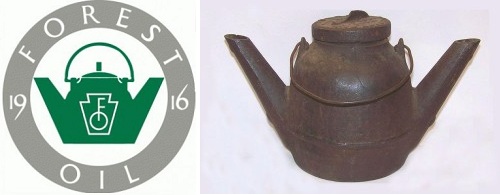
Forest Oil Company adopted the “yellow dog” lantern logo in 1924. eight years after being founded in Bradford, Pennsylvania,
Forest Oil Company‘s oilfield water-injection technology, later adopted throughout the petroleum industry, helped keep America’s first billion dollar oilfield producing to the present day. Patented in 1870, the popular derrick lamp’s name was said to come from the two burning wicks resembling a dog’s eyes glowing at night.
Learn more in Yellow Dog – Oilfield Lantern.
February 13, 1977 – Texas Ranger “El Lobo Solo” dies
“El Lobo Solo” — The Lone Wolf — Texas Ranger Manuel T. Gonzaullas died at age 85 in Dallas. During much of the 1920s and 1930s, he had earned a reputation as a strict law enforcer in booming oil towns.

Texas Ranger Manuel Gonzaullas’ “working pistols” had the trigger guard cut away.
When Kilgore became “the most lawless town in Texas” after discovery of the East Texas oilfield in 1930, Gonzaullas was chosen to tame it. “Crime may expect no quarter in Kilgore,” the Texas Ranger once declared. He rode a black stallion named Tony and sported a pair of 1911 .45 Colts with his initials on the handles.
“He was a soft-spoken man and his trigger finger was slightly bent,” noted independent producer Watson W. Wise in 1985. “He always told me it was geared to that .45 of his.”
Learn more in Manuel “Lone Wolf” Gonzaullas, Texas Ranger

February 15, 1982 – Deadly Atlantic Storm sinks Drilling Platform
With rogue waves reaching as high as 65 feet during an Atlantic cyclone, offshore drilling platform Ocean Ranger sank on the Grand Banks of Newfoundland, Canada, killing all 84 on board. At the time the world’s largest semi-submersible platform, the Ocean Ranger had been drilling a third well in the Hibernia oilfield for Mobil Oil of Canada.
The deadly weather system also engulfed a Soviet container ship 65 miles east of the platform, resulting in the loss of 32 crew members. Recommendations from the 1983 U.S. Coast Guard report would lead to improved emergency procedures, lifesaving equipment, and manning standards for other Offshore Mobil Drilling Unit (MODU) operations.
February 16, 1935 – Petroleum Producing States form Commission
A multi-state government agency that would become the Interstate Oil and Gas Compact Commission was organized in Dallas with adoption of the “Interstate Compact to Preserve Oil and Gas.” Approved by Congress in August, the commission established its headquartered in Oklahoma City.
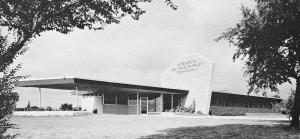
The Interstate Oil and Gas Compact Commission has been based in Oklahoma City since the mid-1930s.
Representatives from Colorado, Illinois, Kansas, New Mexico, Oklahoma and Texas began planning initiatives, “to conserve oil and gas by the prevention of physical waste thereof from any cause.” Oklahoma Gov. Ernest W. Marland — founder of Marland Oil Company in 1921 — was elected first chairman.
“Faced with unregulated petroleum overproduction and the resulting waste, the states endorsed and Congress ratified a compact to take control of the issues,” according to IOGCC, which added the word gas to its name in 1991.
February 17, 1902 – Lufkin Industries founded in East Texas
The Lufkin Foundry and Machine Company was founded in Lufkin, Texas, as a repair shop for railroad and sawmill machinery. When the pine region’s timber supplies began to dwindle, the company discovered new opportunities in the burgeoning oilfields following the 1901 discovery at Spindletop Hill.
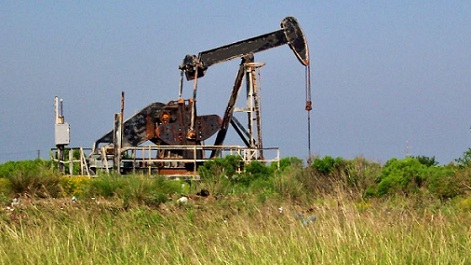
A Lufkin counter-balanced oil pump near Beaumont, Texas, in 2003. Photo by Bruce Wells.
Inventor Walter C. Trout was working for this East Texas company in 1925 when he came up with a new idea for pumping oil. His design would become an oilfield icon known by many names — nodding donkey, grasshopper, horse-head, thirsty bird, and pump jack, among others.
By the end of 1925, a prototype of Trout’s pumping unit was installed on a Humble Oil and Refining Company well near Hull, Texas. “The well was perfectly balanced, but even with this result, it was such a funny looking, odd thing that it was subject to ridicule and criticism,” Trout explained.
Learn more in All Pumped Up – Oilfield Technology.

February 17, 1944 – H.L. Hunt discovers First Alabama Oilfield
Alabama’s first oilfield was discovered in Choctaw County when independent producer H.L. Hunt of Dallas, Texas, drilled the No. 1 Jackson well. Hunt’s 1944 wildcat well revealed the Gilbertown oilfield. Prior to this discovery, 350 dry holes had been drilled in the state.
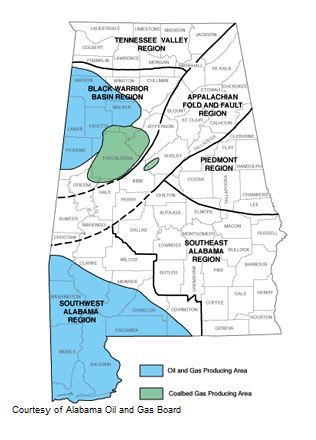
Alabama’s major petroleum producing regions are in the west. Map courtesy Encyclopedia of Alabama.
According to research by petroleum geologist Ray Sorenson, an 1858 report first noted Alabama natural oil seeps about six miles from Oakville in Lawrence County (see Exploring Earliest Signs of Oil). Hunt’s discovery well was drilled in Choctaw County, where he revealed the Gilbertown oilfield at a depth of 3,700 feet.
Although it took 11 years for another oilfield discovery, new technologies and deeper wells in the late 1980s led to the prolific Little Cedar Creek and Brooklyn fields. By the mid-2000s, geologic assessments were underway for the potential of the shales of St. Clair and neighboring counties.
Learn more in First Alabama Oil Well.
_______________________
Recommended Reading: Roadside Geology of Nevada (2027); The Taking of Getty Oil: Pennzoil, Texaco, and the Takeover Battle That Made History
(2027); The Taking of Getty Oil: Pennzoil, Texaco, and the Takeover Battle That Made History (2017); Images of America: Around Bradford
(2017); Images of America: Around Bradford (1997); Lone Wolf Gonzaullas, Texas Ranger (1998); Lufkin, from sawdust to oil: A history of Lufkin Industries, Inc.
(1997); Lone Wolf Gonzaullas, Texas Ranger (1998); Lufkin, from sawdust to oil: A history of Lufkin Industries, Inc. (1982); Lost Worlds in Alabama Rocks: A Guide
(1982); Lost Worlds in Alabama Rocks: A Guide (2000). Your Amazon purchase benefits the American Oil & Gas Historical Society. As an Amazon Associate, AOGHS earns a commission from qualifying purchases.
(2000). Your Amazon purchase benefits the American Oil & Gas Historical Society. As an Amazon Associate, AOGHS earns a commission from qualifying purchases.
_______________________
The American Oil & Gas Historical Society (AOGHS) preserves U.S. petroleum history. Please support energy education, help maintain the AOGHS website, and expand historical research for scribers to the monthly “Oil & Gas History News.” For more information, contact bawells@aoghs.org. Copyright © 2024 Bruce A. Wells. All rights reserved.
by Bruce Wells | Feb 5, 2024 | This Week in Petroleum History
February 5, 1873 – Death of an Illegal Oil Well Shooter –
Andrew Dalrymple, allegedly a frequent “moonlight oil well shooter” in the Tidioute, Pennsylvania, region, was killed in a nitroglycerin explosion at his home on Dennis Run, the Titusville Morning Herald reported. Supplies of nitroglycerin lately had been stolen from magazines throughout the oil region by those seeking to avoid fees for using the Roberts torpedo. “This species of theft is winked at by some parties, who are opposed to the Roberts torpedo patent,” the newspaper noted.
February 5, 1998 – DOE privatizes Elk Hills Petroleum Reserve
The Department of Energy and Occidental Petroleum concluded the largest divestiture of federal property in U.S. history with the sale of Elk Hills Naval Petroleum Reserve in Kern County, California. As the highest corporate bidder, Occidental ended the government’s business operations of oil and natural gas production at the 75-square-mile reserve. The $3.65 billion DOE divestment completed a privatization process that had begun years earlier.

The California Resources Corporation (CRC) in 2018 acquired the former Naval Petroleum Reserve No. 1 in Kern County. California. Map courtesy Wikimedia Commons.
The Clinton Administration in May 1995 had proposed placing the federally-owned Elk Hills reserve on the market in an effort “to reduce the size of government and return inherently non-federal functions to the private sector,” according to the DOE Office of Fossil Energy.
Discovered in 1911 and designated America’s first oil preserve one year later, Elk Hills returned to production following the 1973 oil crisis, becoming one of the top ten most productive U.S. fields. The former Naval Petroleum Reserve No. 1 — made famous by the 1922 “Teapot Dome Scandal” during the Harding administration — was acquired by California Resources Corporation (CRC) in 2018.

February 7, 1817 – First Gas Street Light
Fueled by manufactured gas (distilled from tar and wood), America’s first public street lamp illuminated Market Street in Baltimore, making Gas Light Company of Baltimore the first U.S. commercial gas lighting company. City officials erected a replica of the lamp in 1997.
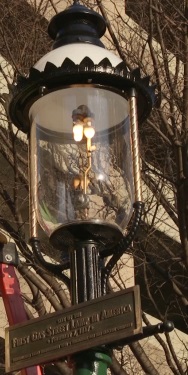
The first U.S. gas street lamp illuminated Baltimore in 1817. Photo courtesy BG&E.
Artist Rembrandt Peale earlier had demonstrated the brightness of manufactured gas with a “ring beset with gems of light” at his Baltimore museum. “During a candlelit period in American history, the forward-thinking Peale aimed to form a business around his gas light innovations, and the exhibition targeting potential investors,” notes Baltimore Gas & Electric (BG&E), which began as the Gas Light Company of Baltimore.
Learn more in Illuminating Gaslight.
February 8, 1836 – Coal Gas brightens Philadelphia
As Philadelphia became America’s center for finance and industry, a municipally owned gas distribution company began lighting Second Street. The newly formed Philadelphia Gas Works ignited 46 lamps that burned manufactured coal gas. In Washington, D.C, manufactured gas began replacing kerosene lamps in the U.S. Capitol by 1847.
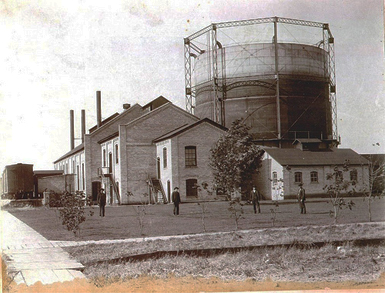
A manufactured gas storage facility at Point Breeze in South Philadelphia, circa 1856. Photograph courtesy Philadelphia Gas Works.
Philadelphia Gas Works in 1856 completed construction of a manufactured gas storage tank with a total capacity of 1.8 million cubic feet, the largest in America at the time. The village of Fredonia, New York, began the first commercial use of natural gas as early as 1825.
February 9, 2013 – Curiosity drills on Mars
Images transmitted from NASA’s robotic rover Curiosity confirmed it successfully drilled on the Martian surface, accomplishing “history’s first ever drilling and sampling into a pristine alien rock on the surface of another planet in our solar system,” according to Universe Today.
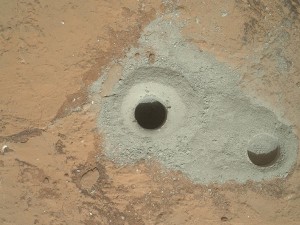
Mars rover Curiosity tested its rotary-percussion bit by making a shallow hole before drilling the first well on another planet. Photo courtesy NASA/JPL.
While exploring the Red Planet’s Yellowknife Bay Basin, Curiosity paused to drill for the first time, making a hole .63 inches wide and 2.5 inches deep. A rotary-percussion drill bit at the end of a seven-foot robotic arm penetrated a “red slab of fine-grained sedimentary rock with hydrated mineral veins of calcium sulfate.”

Curiosity’s “rotary-percussion” bit measured .6 of an inch wide. Photo courtesy NASA/JPL.
Images beamed from the site included a drill test next to the historic borehole. After completing Mars No. 1 (unofficial name), the one-ton rover drilled many others using its slow, “low-percussion” technique. Learn about terrestrial drilling methods in Making Hole – Drilling Technology.
February 10, 1910 – Giant Oilfield discovered in California
Honolulu Oil Corporation discovered the Buena Vista oilfield in Kern County, California. The well, originally known as “Honolulu’s great gasser,” was drilled further into deeper oil-producing sands, and initial production averaged 3,500 barrels of oil a day. Steam injection operations helped the field produce “heavy” (high viscosity) oil from depths of about 4,000 feet.
In 1912, as the Navy began converting its warship boilers from coal to oil (see Petroleum & Sea Power), the San Joaquin Valley oilfield was designated Naval Petroleum Reserve No. 2. In 2000, the Department of Energy leased 90 percent of the 30,000-acre Buena Vista reserves to private oil companies.

February 10, 1917 – Petroleum Geologists get Organized in Tulsa
About 90 geologists gathered in Oklahoma to form an association where “only reputable and recognized petroleum geologists are admitted.” They met at Henry Kendall College, now Tulsa University, to establish the Southwestern Association of Petroleum Geologists, today’s American Association of Petroleum Geologists (AAPG).
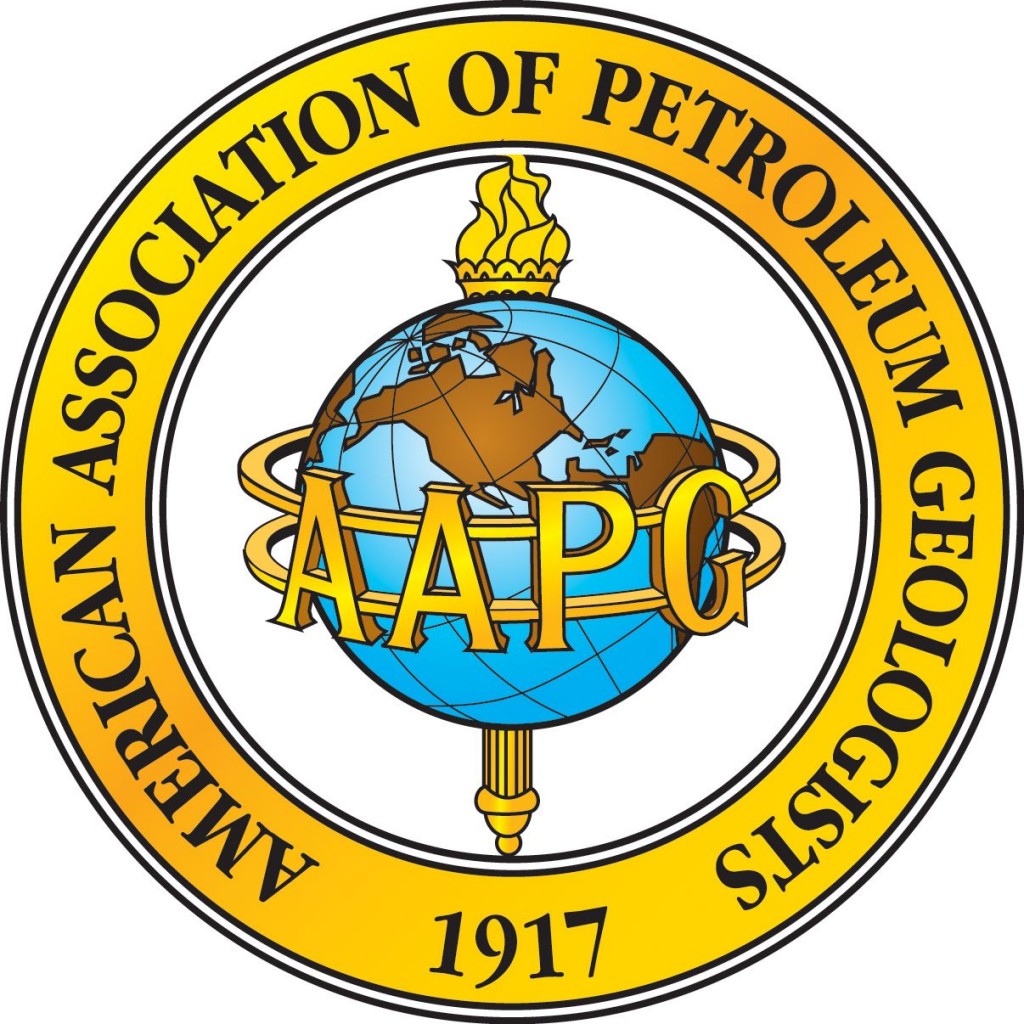
Petroleum geologists celebrated the AAPG centennial in 2017.
Adopting its current name in 1918, AAPG also launched its peer-reviewed scientific journal, the Bulletin. By 1920, industry trade magazines were praising the association’s professionalism and success combating, “unscrupulous and inadequately prepared men who are attempting to do geological work.”
AAPG in 1945 formed a committee to assist the Boy Scouts of America with a geology merit badge. The association’s membership has grown to almost 40,000 members in more than 100 countries.
Learn more in AAPG – Geology Pros since 1917.
February 10, 1956 – Frank Lloyd Wright’s Only Skyscraper
Harold C. Price Sr., founder of the pipeline construction company H.C. Price, dedicated his headquarters building in Bartlesville, Oklahoma. The 19-story concrete and copper office tower remains the only skyscraper designed by architect Frank Lloyd Wright. Wright also designed the Price family residence in Arizona, completed in 1955.
Established in 1921, H.C. Price specialized in field welding oil storage tanks and electric welding of pipelines. The company helped construct the “Big Inch” pipelines during WWII and built large sections of the 800-mile Trans-Alaska Pipeline.

Designed by Frank Lloyd Wright, the Price Tower is listed on the National Register of Historic Places. Photo by Bruce Wells.
Wright designed the Bartlesville “Prairie Skyscraper” in four quadrants, “based on the geometry of a 30-60-90 degree double parallelogram module” with one quadrant for apartments and three for offices, according the current occupant, Price Tower Arts Center. The former H.C. Price Company headquarters at Dewey Avenue and Sixth Street was listed in the National Register of Historic Places in 1974.
_______________________
Recommended Reading: Around Titusville, Pennsylvania, Images of America (2004); Black Gold in California: The Story of California Petroleum Industry
(2004); Black Gold in California: The Story of California Petroleum Industry  (2016); In Pursuit of Fame: Rembrandt Peale, 1778-1860 (1993); Mars Rover Curiosity: An Inside Account from Curiosity’s Chief Engineer
(2016); In Pursuit of Fame: Rembrandt Peale, 1778-1860 (1993); Mars Rover Curiosity: An Inside Account from Curiosity’s Chief Engineer (2017); Trek of the Oil Finders: A History of Exploration for Petroleum (1975); Building Bartlesville, 1945-2000, Images of America: Oklahoma
(2017); Trek of the Oil Finders: A History of Exploration for Petroleum (1975); Building Bartlesville, 1945-2000, Images of America: Oklahoma (2008). Your Amazon purchase benefits the American Oil & Gas Historical Society. As an Amazon Associate, AOGHS earns a commission from qualifying purchases.
(2008). Your Amazon purchase benefits the American Oil & Gas Historical Society. As an Amazon Associate, AOGHS earns a commission from qualifying purchases.
_______________________
The American Oil & Gas Historical Society (AOGHS) preserves U.S. petroleum history. Become an AOGHS annual supporting member and help maintain this energy education website and expand historical research. For more information, contact bawells@aoghs.org. Copyright © 2024 Bruce A. Wells. All rights reserved.






(2027); The Taking of Getty Oil: Pennzoil, Texaco, and the Takeover Battle That Made History
(2017); Images of America: Around Bradford
(1997); Lone Wolf Gonzaullas, Texas Ranger (1998); Lufkin, from sawdust to oil: A history of Lufkin Industries, Inc.
(1982); Lost Worlds in Alabama Rocks: A Guide
(2000). Your Amazon purchase benefits the American Oil & Gas Historical Society. As an Amazon Associate, AOGHS earns a commission from qualifying purchases.









